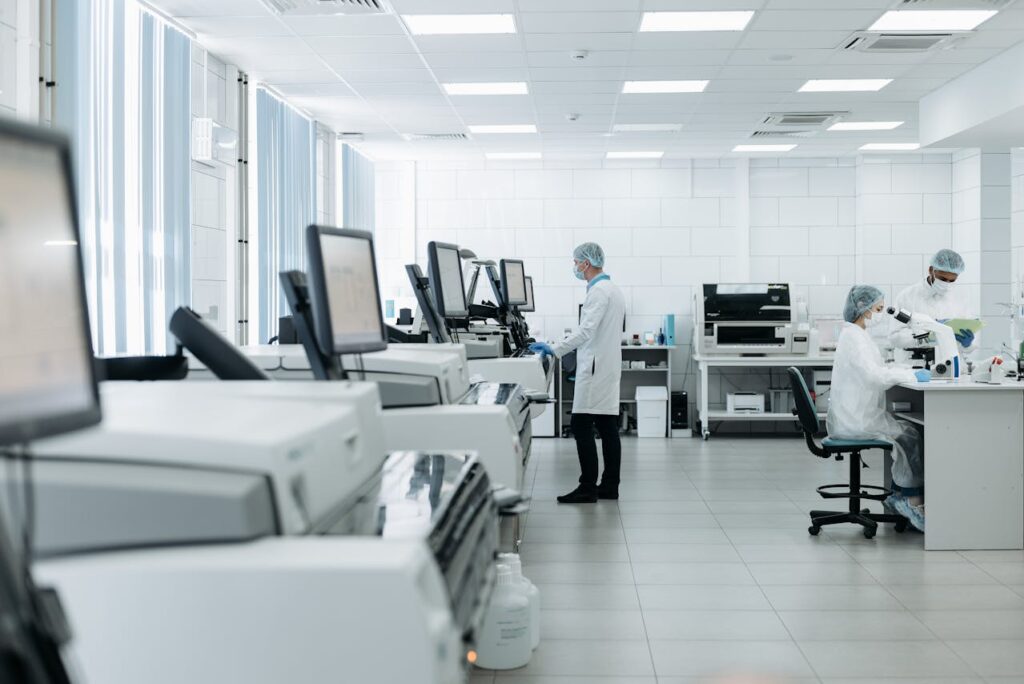Liquid chromatography-mass spectrometry (LC-MS) is a cutting-edge analytical technique used to identify, quantify, and characterize compounds in complex matrices. Thanks to its high sensitivity and accuracy, LC-MS is now an essential tool in many industrial sectors: pharmaceutical, food , cosmetics , environment , and many more. Its coupling between chromatographic separation and spectrometric analysis makes it possible to obtain detailed results on the chemical composition of a sample, even in the presence of impurities or contaminants at very low concentrations.
In this article, we will explore how LC-MS works, its industrial applications, as well as its advantages and limitations. You will also discover how YesWeLab, thanks to its network of more than 200 laboratories and its innovative digital platform , supports you in your analytical needs, guaranteeing you reliable analyses that comply with current regulations.
Table of Contents
Introduction to LC-MS
Definition of liquid chromatography coupled with mass spectrometry (LC-MS)
LC -MS (Liquid Chromatography-Mass Spectrometry) is an analytical technique that combines two complementary technologies:
- Liquid chromatography (LC) , which allows the components of a mixture to be separated according to their chemical properties.
- Mass spectrometry (MS) , which identifies and quantifies these components by analyzing their mass/charge ratio (m/z) .
This method is particularly appreciated for its extreme sensitivity and high specificity infinitesimal levels in complex samples. It has thus become indispensable in quality control, research and development, as well as the analysis of contaminants .
Importance of LC-MS in the analysis of chemical compounds
LC-MS plays a central role in many industrial and scientific fields, as it allows:
Precise identification of molecules : Mass spectrometry provides a detailed spectrum that allows the chemical structure of compounds to be identified.
Reliable quantification of the substances present : It allows the exact concentration of an analyte to be measured, which is essential in the pharmaceutical and food industries.
Analysis of complex mixtures : Unlike other techniques, LC-MS can analyze samples containing many compounds, without extensive prior separation.
Rigorous quality control : Whether to verify the conformity of a product or detect the presence of impurities, LC-MS is a benchmark tool.
Advantages of LC-MS over other analytical techniques
Compared to other analytical methods such as gas chromatography-mass spectrometry (GC-MS) or infrared (IR) , LC-MS has several major advantages:
- Analysis of non-volatile and thermosensitive compounds : Unlike GC-MS, LC-MS allows the analysis of non-volatile (e.g. biomolecules, peptides, polymers) that could not be studied by gas chromatography.
- Trace detection at extremely low concentrations : Thanks to high-resolution detectors and tandem mass spectrometry (MS/MS), LC-MS achieves detection levels in the nanogram per liter range .
- Fast and efficient analysis without chemical derivatization : Unlike some methods requiring prior sample transformation (e.g. GC-MS which often requires chemical derivatization), LC-MS allows direct and rapid analysis.
- Versatility and adaptability : LC-MS can be used with different stationary and mobile phases , allowing adaptation to the specificities of each analysis (e.g.: analysis of proteins, pesticides, drugs, etc.).
Are you looking for an analysis?

How LC-MS works
Liquid chromatography-mass spectrometry (LC-MS) is a two-step process that is distinct but complementary. Liquid chromatography (LC) separates the analytes present in a sample, while mass spectrometry (MS) enables their identification and quantification with high accuracy. This combination makes LC-MS a powerful analytical technique widely used in many scientific and industrial fields.
Chromatographic separation (LC)
Liquid chromatography is the first step in the LC-MS process. It separates the different compounds present in a complex mixture based on their physicochemical properties. This separation is based on the interaction of the analytes with two distinct phases:
- The mobile phase : a liquid solvent (e.g., water, acetonitrile, methanol) that transports the analytes through the chromatographic column.
- The stationary phase : a solid material (e.g., modified silica) fixed inside the column, which interacts differently with each analyte depending on its chemical properties.
When the sample is injected into the column, each analyte migrates at a specific speed depending on its affinity for the stationary phase and its solubility in the mobile phase. This results in a progressive separation of the compounds, which will then be detected and analyzed by mass spectrometry.
Differences between HPLC, UPLC and standard LC
Liquid chromatography can be performed under different conditions, depending on the level of performance required:
- Standard LC (Liquid Chromatography) : classic chromatography method, with moderate pressures and standard diameter columns.
- HPLC (High-Performance Liquid Chromatography) : optimized technique with higher pressure and more efficient columns, allowing finer separation and better analytical resolution.
- UPLC (Ultra-Performance Liquid Chromatography) : An advanced version of HPLC using even higher pressures and smaller stationary phase particles, allowing for faster and more accurate analyses.
UPLC generally offers better resolution, increased sensitivity, and reduced analysis time compared to HPLC, making it a preferred choice for applications requiring high precision and short turnaround times.
Mass spectrometry (MS) detection
Once the analytes have been separated by chromatography, they are transferred to the mass spectrometer, which allows their chemical structure to be identified and their concentration to be quantified. This analysis is based on the principle of the mass/charge ratio (m/z) .
Principle of mass/charge ratio (m/z)
In a mass spectrometer, molecules of interest are transformed into ions through an ionization process. These ions are then directed into the mass analyzer, which measures their mass-to-charge ratio (m/z) . Each analyte produces a unique mass spectrum, which allows its structure and molecular mass to be determined.
Different ionization methods: ESI and APCI
The effectiveness of mass spectrometry depends largely on the ionization method used. Two main techniques are commonly used in LC-MS:
- Electrospray Ionization (ESI) :
- A gentle technique that generates ions from liquid samples by applying a high electrical voltage.
- Ideal for polar and ionizable compounds such as peptides, proteins and metabolites.
- Produces ions with little or no fragmentation, allowing for accurate identification.
- Atmospheric Pressure Chemical Ionization (APCI) :
- Uses a carrier gas to ionize analytes at atmospheric pressure.
- More suitable for less polar and less volatile (e.g. hydrocarbons, lipids).
- May result in greater fragmentation, facilitating the identification of complex chemical structures.
The choice between ESI and APCI depends on the nature of the analytes and the analytical objectives. ESI is preferred for the analysis of biomolecules and ionizable compounds, while APCI is more suitable for neutral or slightly polar molecules.
Mass spectra and interpretation of results
Once the ions are generated, they are separated and detected based on their mass/charge ratio (m/z) , producing a mass spectrum . This spectrum represents the relative abundance of the ions as a function of their m/z, which allows:
- Compound identification : each analyte has a unique mass spectrum, which can be compared to reference databases.
- Determination of molecular mass : essential for characterizing the chemical structures of analytes.
- Structural analysis via fragmentation : In MS/MS (tandem mass spectrometry), precursor ions can be fragmented to provide detailed information on the molecular structure of the compounds studied.
The combination of liquid chromatography and mass spectrometry thus offers a robust analytical approach, allowing the precise identification and quantification of a wide variety of compounds, even in the presence of complex matrices.

Applications of LC-MS in industry
Liquid chromatography-mass spectrometry (LC-MS) is widely used in various industrial sectors due to its ability to identify, quantify and characterize complex compounds with high accuracy. Thanks to its high sensitivity and versatility, this technique has become a benchmark analytical tool for quality control, regulatory compliance and contaminant analysis .
Food industry and nutrition
In the food industry, LC-MS is an essential tool for guaranteeing food safety and ensuring its traceability . In particular, it allows the detection of contaminants at extremely low concentrations, in compliance with current regulatory standards (EFSA, FDA).
Cosmetic
- Detection of contaminants (pesticides, mycotoxins, heavy metals)
LC-MS can detect and quantify a wide range of contaminants that can affect food safety:
- Pesticides and chemical residues from agriculture
- Mycotoxins produced by certain molds in cereals, dried fruits and dairy products
- Heavy metals (lead, cadmium, mercury) present in seafood and certain crops
- Quality control and product traceability
Thanks to LC-MS, it is possible to carry out detailed analyses on the nutritional composition of foods (vitamins, amino acids, antioxidants), but also to verify the conformity of labels and nutritional claims.
The cosmetics industry is subject to strict regulations to ensure consumer safety . LC-MS allows the chemical composition of cosmetic products , unwanted substances to be detected and their stability to be guaranteed.
- Identification of allergens and regulated substances
LC-MS can detect the presence of regulated substances such as:
- Parabens and preservatives banned or restricted
- Allergens present in perfumes and creams
- Heavy metals may be present in traces in makeup and skincare products
- stability
and efficacy This technique is used to monitor the evolution of cosmetic formulas over time, by checking the stability of the active ingredients and detecting any degradation that could impact the product's efficacy.
Environment
Environmental analysis by LC-MS makes it possible to detect and quantify chemical pollutants in different environments, thus contributing to the prevention of health risks and the preservation of ecosystems .
- Detection of pollutants in water, air and soil
LC-MS analyses are commonly used to identify persistent organic contaminants , such as:- Pesticides and agricultural residues in groundwater
- Industrial pollutants ( hydrocarbons, solvents) in the air and soil
- Endocrine disruptors ( bisphenol A, phthalates) in wastewater
- Industrial discharge monitoring and regulatory compliance
Many environmental regulations require regular monitoring of industrial discharges . LC-MS allows these analyses to be carried out with great precision, thus ensuring compliance with current standards (REACH directive, ICPE regulations).
Pharmaceutical industry
LC-MS plays a central role in drug development and control, ensuring the quality, efficacy, and safety of pharmaceutical substances throughout their life cycle.
- Analysis of active ingredients and impurities
LC-MS is used to verify the purity of active ingredients and identify possible impurities resulting from manufacturing processes or drug degradation. This approach is essential to ensure compliance with the requirements of international pharmacopoeias (USP, EP). - Drug quality control
The technique is used to accurately quantify active substances in pharmaceutical formulations (tablets, capsules, injectable solutions) and detect possible cross-contamination or degradation products.
Other sectors: packaging, materials, animal health
- Packaging and materials in contact with food
LC-MS is used to analyze migrating substances that can pass from packaging to food (inks, plasticizers, manufacturing residues), thus ensuring compliance with European regulations (EC No. 1935/2004). - Materials and polymers industry
This technique makes it possible to study the chemical composition of polymers , to check their thermal and chemical stability , and to identify possible volatile compounds. - Animal Health
LC-MS is used to control the quality of animal feed , detect the presence of unauthorized veterinary drugs , and monitor the contamination of animal products (milk, eggs, meat).
Thanks to its versatility and precision , LC-MS is today an essential analytical tool in many industrial sectors, helping to ensure the quality, safety and regulatory compliance of products.

4. Advantages and limitations of LC-MS
Liquid chromatography-mass spectrometry (LC-MS) is an essential analytical method in many industrial and scientific sectors. Thanks to its high sensitivity, precision and versatility , it allows the identification and quantification of complex chemical compounds in various matrices. However, like any analytical technique, it also has certain limitations that are important to consider when using it.
Advantages of LC-MS
1. High sensitivity and specificity
LC-MS enables the detection and quantification of substances at very low concentrations, often down to nanogram per liter (ng/L) or even picogram per liter (pg/L) levels in some cases. This detection capability is particularly valuable for analyzing contaminants, impurities, or residues in complex samples.
In addition to its sensitivity, LC-MS offers very high specificity. Thanks to tandem mass spectrometry (MS/MS), it is possible to accurately identify a particular compound, even in the presence of other substances with similar characteristics.
2. Ability to analyze complex samples
Unlike other techniques such as gas chromatography-MS (GC-MS), which often requires extensive sample preparation, LC-MS is capable of directly analyzing complex matrices such as:
- Biological fluids (blood, urine, plasma)
- Plant or food extracts
- Pharmaceutical and cosmetic products
- Environmental samples ( water, soil, air)
This flexibility allows LC-MS to be used in fields as varied as pharmacology, food processing, the environment and cosmetics .
3. Accurate identification of chemical compounds
Mass spectrometry allows the determination of the mass/charge ratio (m/z) of the generated ions, providing extremely precise identification of analytes. Combined with mass spectral databases, LC-MS allows:
- To recognize unknown molecules
- To confirm the presence of a specific compound
- To identify biological markers or contaminants
In applications such as pesticide residue detection, drug purity verification or cosmetic allergen analysis, this precision is a major asset.
4. Compatible with a wide range of dies
LC-MS can be applied to a wide variety of samples , whether liquid, semi-solid or even solid after proper extraction. Unlike GC-MS, which is limited to volatile analytes, LC-MS can analyze:
- Polar and non-volatile molecules (e.g. proteins, metabolites, food additives)
- Heat-sensitive compounds that degrade at high temperatures
- Ionizable analytes in aqueous or organic solvents
This compatibility makes it a tool of choice for various analyses, ranging from monitoring environmental contaminants to the characterization of pharmaceutical excipients.
Limitations of LC-MS
1. Requires soluble and ionizable analytes
One of the main challenges of LC-MS is that not all analytes are compatible with this technique . To be detected, a compound must:
- Be soluble in the mobile phase used (water, methanol, acetonitrile, etc.)
- Be ionizable by one of the ionization techniques (ESI, APCI, etc.)
Some neutral or very slightly polar compounds can be difficult to analyze by LC-MS without prior chemical modifications, such as sample derivatization or the use of specific solvents.
2. Presence of matrix effects that may influence the results
The analysis of complex samples can be confounded by matrix effects , which can suppress or amplify the signal of certain analytes. For example:
- Proteins , lipids or salts present in a biological sample can interfere with ionization and distort the results.
- Some food co-extractants (colors, preservatives) may mask peaks or cause artifacts in mass spectra.
To limit these effects, optimization strategies must be implemented, such as the use of internal standards, specific calibrations or advanced purification protocols before analysis.
3. Cost and technical complexity of instrumentation
One of the major drawbacks of LC-MS is its high cost and demanding maintenance :
- LC-MS instruments are more expensive than conventional HPLC systems or other analytical methods.
- The analysis requires highly qualified technicians , capable of correctly interpreting mass spectra and optimizing experimental conditions.
- Maintenance of devices (ionization chambers, mass detectors, vacuum pumps) can lead to additional costs and require frequent interventions.
Additionally, the use of LC-MS often involves a longer analysis time , especially when performing analyses in MS/MS or with very complex separation methods.
Despite these limitations, LC-MS remains an essential technique in many fields, offering a unique combination of sensitivity, precision and flexibility . Its use continues to expand thanks to technological advances, which gradually reduce its drawbacks while improving its analytical performance.

YesWeLab: your expert partner in LC-MS analyses
LC -MS is an essential technique for the analysis of chemical compounds in various industrial sectors. YesWeLab , thanks to its network of more than 200 partner laboratories in France and Europe, supports manufacturers by offering them high-performance analytical solutions that comply with the strictest regulatory standards.
YesWeLab's expertise spans many fields, including pharmaceuticals, food, cosmetics, materials, and the environment . LC-MS can identify impurities, detect contaminants, and monitor product compliance. For example, in the pharmaceutical sector, it is essential for validating active ingredients and monitoring degradation products. In the food industry, it can quantify pesticide and mycotoxin residues, ensuring consumer safety. In the cosmetics and packaging industries, it plays a key role in detecting allergens and regulated substances.
YesWeLab stands out for its innovative digital platform , which simplifies and accelerates analysis management. Manufacturers can order their analyses, track their samples in real time, and receive their results transparently. This approach saves significant time and allows for more efficient management of analytical needs.
Conclusion
Liquid chromatography-mass spectrometry (LC-MS) has established itself as an essential technique for the analysis and quantification of chemical compounds in complex matrices. Thanks to its high sensitivity and precision, it is now used in many sectors, from pharmaceuticals to food, cosmetics, and the environment. Its ability to detect impurities and contaminants at minute concentrations makes it an essential tool for quality control and regulatory compliance.
However, implementing LC-MS analyses requires in-depth expertise and access to cutting-edge equipment. YesWeLab addresses these challenges by offering a complete and centralized solution for manufacturers. Thanks to its network of partner laboratories , its innovative digital platform and its commitment to ISO 17025 and COFRAC standards , YesWeLab allows companies to optimize their analyses while guaranteeing reliable and usable results.
Whether for raw material control, contaminant monitoring, or validation of new formulations, YesWeLab supports manufacturers in their analytical challenges by offering them an expert and customized approach. Contact YesWeLab today to benefit from LC-MS analyses adapted to your requirements and current regulations.




